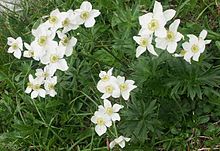Anemone narcissiflora
| Anemone narcissiflora | |
|---|---|
 |
|
| Scientific classification | |
| Kingdom: | Plantae |
| (unranked): | Angiosperms |
| (unranked): | Eudicots |
| Order: | Ranunculales |
| Family: | Ranunculaceae |
| Genus: | Anemone |
| Species: | A. narcissiflora |
| Binomial name | |
|
Anemone narcissiflora L. |
|
Anemone narcissiflora, the narcissus anemone or narcissus-flowered anemone, is a herbaceous perennial in the genus Anemone and the buttercup family.
Plants grow 7 to 60 cm (2 3⁄4 to 23 1⁄2 inches) tall, from a caudex (woody-like perennial base), flowering spring to mid summer but often found flowering till late summer. They have 3-10 basal leaves that are ternate (arranged with three leaflets), rounded to rounded triangular in shape with 4-to-20-millimetre (5⁄32-to-25⁄32-inch) long petioles.
The flowers are produced in clusters (umbels) with 2 to 8 flowers, but often appear singly. The inflorescence have 3 leaf-like bracts similar in appearance to the basal leaves but simple and greatly reduced in size, pinnatifid in shape. Flowers have no petals, but instead have 5-9 petal-like sepals that are white, blue-tinted white or yellow in color. The flowers usually have 40 to 80 stamens but can have up to 100.
After flowering, fruits are produced in rounded heads with 5–14-centimetre (2–5 1⁄2-inch) long pedicels. When the fruits, called achenes, are ripe they are ellipsoid to ovate in outline, flat in shape and 5 to 9 millimetres (3⁄16 to 11⁄32 in) long and 4–6 millimetres (5⁄32–1⁄4 in) wide. The achenes are winged with no hairs and have 0.8–1.5-millimetre (0.031–0.059-inch) long beaks that are curved or recurved.
Anemone narcissiflora is native to north western North America and Eurasia where it can be found growing in high mountain alpine grasslands, in thickets, grassy meadows with moist soils, tundra, open woods, along roadsides and in pastures.
...
Wikipedia
